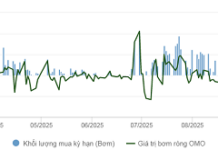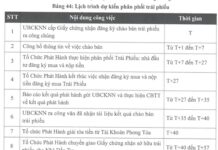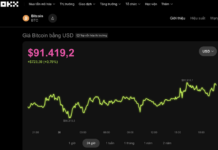Global gold prices rose but failed to break through during Thursday’s trading session (August 15) as US retail and weekly unemployment data were more optimistic than expected. This data caused the market to reduce its bets on the possibility of a 50-basis-point rate cut by the Federal Reserve (Fed) in the September meeting, thus strengthening the US dollar and putting downward pressure on gold prices.
At the close, New York spot gold prices rose $9.1/oz, or 0.37%, to $2,457.3/oz. During the session, there was a time when gold prices rose by 0.9%, but this gain could not be maintained as the US dollar strengthened.
As of 7 a.m. Vietnam time today (August 16), spot gold prices in the Asian market were up $0.8/oz from the US close, trading at $2,458.1/oz. Converted at Vietcombank’s selling exchange rate, this price is equivalent to nearly VND 74.7 million/troy ounce, up VND 300,000/troy ounce from yesterday morning.
According to a report from the US Department of Commerce, July retail sales rose 1%, far exceeding the forecast of a 0.3% increase in a Dow Jones poll of economists. In addition, a weekly report from the US Department of Labor showed that the number of initial jobless claims unexpectedly fell by 7,000 to 227,000 in the week ending August 10, compared to a forecast of 235,000.
After the above data was released, US dollar rates and US Treasury yields rose simultaneously, making it difficult for gold prices to maintain their upward momentum.
The Dollar Index, which measures the strength of the US dollar against a basket of six other major currencies, closed Thursday’s session up 0.4% at nearly 103 points. The index continued to rise and broke above 103 points in the early hours of this morning.
The yield on the 10-year US Treasury note rose nearly 10 basis points to 3.921%. The yield on the 2-year note rose more than 14 basis points to 4.093%.

“Retail sales data were very positive, indicating that the economy is still healthy. This caused a shift in the market, with the US dollar regaining strength and gold losing some of its appeal,” said Chris Gaffney, president of EverBank, in remarks to Reuters.
With inflation data released this week showing a continued decline in inflation in the US economy, investors are confident that the Fed will cut interest rates at the September meeting. Speaking on Thursday, two hawkish Fed officials signaled support for a rate cut at next month’s meeting.
According to data from the FedWatch Tool of the CME trading floor, the market is betting on a 100% chance of a Fed rate cut in September.
However, better-than-expected retail and unemployment data are causing investors to rule out the possibility of a 50-basis-point rate cut by the Fed in the first cut. Instead, traders are betting on a 75% chance of a 25-basis-point rate cut and only a 25% chance of a 50-basis-point cut.
A smaller rate cut could hinder gold’s advance, as the market has recently expected a larger rate cut.
According to Valeria Bednarik, chief analyst at FXStreet, gold’s lower highs and lower lows are a bearish sign for the short-term outlook, but the likelihood of a sharp decline in prices is low.
“Gold’s technical factors have weakened somewhat, but remain at healthy levels, limiting the potential for deep losses… Overall, a sharp decline in gold prices is unlikely,” Bednarik told Kitco News.







































